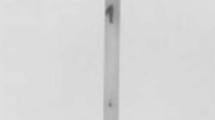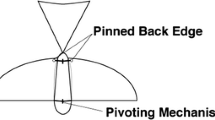Abstract
A flying hot-wire arrangement has been developed for the measurement of the velocity characteristics of the flow around airfoils, and particularly in regions where negative values of instantaneous velocity occur. The mechanism and signal processing system are described and appraised by comparing stationary and flying wire measurements obtained in the trailing edge region of a flap at an angle of attack which leads to upper-surface separation.
Similar content being viewed by others
Abbreviations
- 〈〉:
-
time averaged quantity
- E :
-
voltage from hot wire anemometer
- Q, φ:
-
magnitude and direction of cooling velocity viewed from a frame of reference on the probe: 〈Q〉=〈U〉+〈V p〉
- q 1, q 2, q 3 :
-
cooling velocity fluctuations oriented with respect to the φ-direction
- Q eff :
-
magnitude of effective cooling velocity measured by the hot wire: Q eff = (Q N1 2 + h 2 Q N2 2 + k 2 Q T 2 1/2
- t :
-
time
- q eff :
-
fluctuations of the effective cooling velocity
- Q N1, Q N2, Q T :
-
axial, normal and tangential components of the cooling velocity relative to the hot wire
- Q eff (Ψ= 10°):
-
magnitude of the effective cooling velocity with
- Q eff (Ψ = 0°) Q eff (α = 30°):
-
magnitude of the effective cooling velocity with the wire pitched at 10 ° and 0° to the flow velocity
- Q eff (α = 45°) Q eff (α = 30°):
-
magnitude of the effective colling velocity with the wire yawed at 45° and 30° to the flow velocity
- U, θ:
-
magnitude and direction of flow velocity
- u, v, w :
-
flow velocity fluctuations (x, y, z)
- u 1, u 2, u 3 :
-
normalised fluctuations of cooling velocity: u i=q i〈Q〉 for i=1,2,3
- V p, β:
-
magnitude and direction of probe velocity
- v p :
-
probe velocity fluctuations along the β-direction
- α:
-
yaw angle of hot wire relative to the probe axis
- Δ:
-
angle of mean flow velocity to the probe axis
- γ:
-
angle of mean axial cooling component to mean cooling velocity viewed from the wire
- ψ:
-
pitch angle of probe axis relative to tunnel coordinates (x, y, z)
- x, y, z :
-
orthogonal coordinate system with the x-direction aligned with the wall (boundary layer) or tunnel centre-line (wake)
- x w, y w, z w :
-
orthogonal coordinate system with the z w-direction aligned with the wire and the probe pintels in the x w- z w plane
References
Adair, D.; Thompson, B. E.; Whitelaw, J. H., 1983: Measurements and calculations of a two-dimensional separating boundary layer and the downstream wake. 2nd Symposium on Physical and Numerical Aspects of Aerodynamic Flows, Long Beach. Berlin, Heidelberg, New York (in Press)
Castro, I. P.; Cheun, B. S., 1982: The measurement of Reynolds stresses with a pulsed-wire anemometer. J. Fluid Mech. 118, 41
Champagne, F. H.; Sleicher, C. A., 1967: Turbulence measurements with inclined hot-wires. J. Fluid Mech. 28, 177
Coles, D.; Cantwell, B.; Wadcock, A., 1978: The flying hot wire and related instrumentation. NASA CR 3066
Coles, D.; Wadcock, A., 1979: Flying hot-wire study of flow past an NACA 4412 airfoil at maximum lift. AIAA 17, 321
Durst, F.; Melling, A.; Whitelaw, J. H., 1981: Prinicples and practive of laser-doppler anemometry. 2nd Ed. London, New York: Academic Press
Gibson, M. M.; Verriopoulos, C.; Vlachos, N. S., 1983: Turbulent boundary layer on a mildly curved convex surface: Part I. Mean flow velocity and turbulence measurements. Imperial College Report FS/83/6
Muller, U. R., 1982: On the accuracy of turbulence measurements with inclined hot wires. J. Fluid Mech. 119, 115
Nakayama, A., 1983: Measurements of attached and separated turbulent flows in the trailing-edge regions of airfoils. 2nd Symposium on Physical and Numerical Aspects of Aerodynamic Flows, Long Beach. Berlin, Heidelberg, New York: Springer
Ribeiro, M. M., 1976: The turbulence structure of free jet flows with and without swirl. PhD. thesis, University of London
Rodi, W., 1971: A new method for analysing hot-wire signals and its evaluation in a round jet. Imp. College Mech. Eng. Rept ET/TN/B/10
Simpson, R. L., Chew, Y.; Shivaprasad, B. G., 1981: The structure of a separating turbulent boundary layer, Part 2. J. Fluid Mech. 113, 53
Simpson, R. L.; Strickland, J. H.; Barr, P. W., 1977: Features of a separating turbulent boundary layer in the vicinity of separation. J. Fluid Mech. 79, 553
Thompson, B. E., 1983: Appraisal of a flying hot-wire anemometer. DISA Information (in press)
Thompson, B. E.; Whitelaw, J. H., 1982: A turbulent boundary layer approaching separation. Walt-Festschrift Volume, p. 253. Berlin, Heidelberg, New York: Springer
Watmuff, J. H.; Perry, A. E.; Chong, M. S. 1983: A flying hot-wire system. Exp. Fluids 1, 63–71
Author information
Authors and Affiliations
Rights and permissions
About this article
Cite this article
Thompson, B.E., Whitelaw, J.H. Flying hot-wire anemometry. Experiments in Fluids 2, 47–55 (1984). https://doi.org/10.1007/BF00266318
Received:
Issue Date:
DOI: https://doi.org/10.1007/BF00266318




